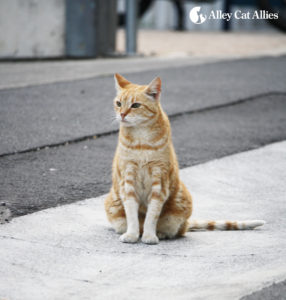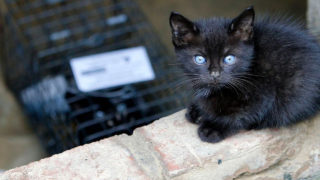A landmark study on a college campus that was once hostile to its community cat population has proven what Alley Cat Allies has observed time and again: Targeted Trap-Neuter-Return (TNR) programs are extremely effective in stabilizing cat populations over time.
The nine-year study of campus cats at the University of New South Wales in Sydney, Australia, published in May, also found that TNR reduced university costs associated with catching and killing cats, improved the health of cats, and led to fewer concerns from the public about the cats.

Pearl, a community cat who was part of the University of New South Wales Trap-Neuter-Return program, was featured in Alley Cat Allies’ 2016 National Feral Cat Day campaign.
Although the university had been against a TNR program, support for the program grew when administrators witnessed the benefits. From August 2008 to September 2017, the campus population of 69 cats decreased to 15, according to the study published in the journal Animals.
“This study has clearly demonstrated the advantages of using a humane, nonlethal, cat management approach,” says Helen Swarbrick, president of the Campus Cats NSW nonprofit, which oversees the care of the cats, and a professor at the university. “[TNR] builds institutional and community support and maintains the health of the cat population. This is very different from outcomes from trap and kill approaches, which may appear to be a quick fix, but which do not actually show good efficacy over time.”
At the start of the program, volunteer students, staff, and community members identified the cats living on campus. Cats were trapped, spayed or neutered, vaccinated, treated for minor health issues, microchipped, and returned outdoors. Volunteers fed the cats daily, with a carefully measured amount of food calculated per cat.
New unsocialized cats who appeared became part of the TNR program. Socialized cats and kittens born on campus were placed in homes with people. Daily feeders monitored cats closely. Eventually, motion-activated cameras were used to identify campus cats.
Over the years, veterinarians treated cats for dental disease, eye infections, minor injuries, abscesses, and skin conditions, which “differed little from the spectrum of minor illnesses seen in the domestic cat population,” according to the study.
“When we started the TNR program there was a lot of skepticism about this approach from the university,” says Swarbrick. “There was also open hostility from some members of the campus community.”
The 94-acre campus, which has a population of about 53,000 students and 6,000 staff, is located in the suburbs of Sydney. The Campus Cat Coalition (CCC) formed in 2000 to carry out TNR, but faced opposition and lacked university support and funding, hindering the program’s success.
“We were doing the best that we could with limited funds and help,” says Colleen Ringe, treasurer of Campus Cats NSW and retired university staff member who was part of the CCC. She says the CCC worked “under the threat of cats being caught” and killed.
The university hired a pest management company to remove the cats in 2008, but halted the scheme following a backlash from university staff who were against the killing of cats. Also, it discovered that some of those cats had already been microchipped and neutered.
About two months after, CCC proposed a yearlong TNR trial program on the campus, with a goal of sterilizing 95 percent of the cats by the end of 2009. The university funded part of the program initially and the CCC secured additional funding through donations and fundraising. The university observed the benefits of the program and kept it going.
“We now have unqualified support from the institution and receive active help from university security, grounds and maintenance staff,” says Swarbrick. “After a few years of struggling to maintain support for the daily feeding routine, I now have a waiting list of volunteers who want to help with cat feeding! And the program is now self-supporting from donations.”
The TNR program was successful due to “persistence and hard, ongoing work,” she says. This study showed the importance of continuing to monitor and manage colonies to ensure any new cats who show up are spayed or neutered, she adds.
“The big difference I see in the cats now is how loved they are by the campus community,” says Ringe.

